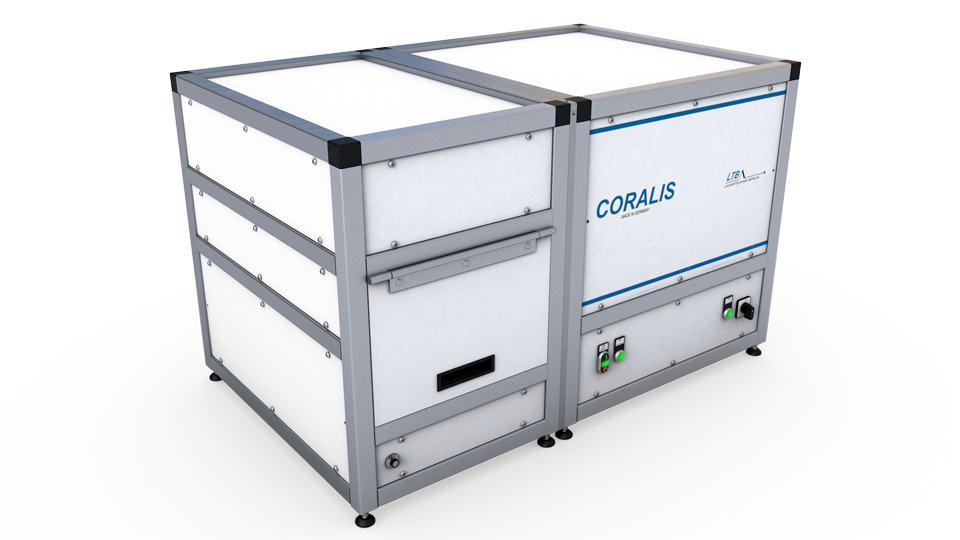CORALIS

The CORALIS system unites the two high complementary techniques LIBS and RAMAN. By means of a high-quality sample image, pre-selected measurement positions are analysed either with Raman or LIBS or with both methods sequentially.
The unique two-wing echelle spectrometer as core part is able to provide high resolution, large range and high light-throughput on an unbeatable level. The laser-safe housing and the integrated interlocking circuit ensure user-friendly handling of the device and
protection of the installed components.
Setup
CORALIS (COmbined RAman LIbs System) provides unique advantages for applications in the fields of technical cleanliness, particle analysis, forensics and others due to the exceptional combination of imaging, molecular and elemental analysis.
By using an automated CMOS-based 6 Mpixel camera and a choice of two microscopic objectives, the CORALIS delivers a highly resolved overview or detailed close-up image. An integrated imaging analysis algorithm supports automatic particle recognition as well as the analysis of particle size, size distribution and particle counting. The imaging mode is also used to define the regions of interest for the following molecular and elemental analysis.
The further analysis of the sample or particle can be done with RAMAN or LIBS or both techniques sequentially. CORALIS contains two different RAMAN lasers @ 532nm and 785nm. The molecular information carried by the RAMAN signal is collected by a high efficient mirror optic and guided via free-beam optics to the Aryelle spectrometer. Further improvements of the high-resolution RAMAN signal can be done by the background correction integrated in the user-friendly FusionRL software package. Analysis of RAMAN spectra can either be done in the FusionRL itself or by simple export to the well-known and established KnowItAll® spectroscopy software from Wiley.
Complementary to the molecular analysis done by RAMAN, the CORALIS provides a detailed elemental analysis realized by high-resolution LIBS. The second optical path is optimized for the short-pulse plasma analysis. The excellent spectral resolution together with the broad wavelength range down to the deep UV range allows to get detailed fingerprint sufficient for classification as well as quantification.
Specifications
| Measuring technique | Laser-induced breakdown spectroscopy (LIBS) | qualitative and quantitative multi-elemental analysis |
| RAMAN spectroscopy | analysis of molecule structures by the detection and interpretation of scattered light |
|
| Imaging | Particle counting, size distribution,… | |
| LIBS | Laser | 1064nm (up to 50 mJ pulse energy) |
| Wavelength range | 190 nm – 520 nm | |
| Resolution | 13 pm – 35 pm | |
| RAMAN | Laser | 532 nm and 785 nm ( up to 50 mW) |
| Wavelength range | 530nm – 950 nm (up to 6000 cm-1) | |
| Resolution | 532nm: 2.5 – 2.0 cm-1 785nm: 1.7 – 1.4 cm-1 |
|
| XYZ-stage | Travel range | X = 50 mm , Y = 50 mm, Z = 35 mm |
| Resolution | 1 µm | |
| Repeatability | 1 µm | |
| Sample Imaging | CMOS camera-based | 6 Mpixel |
| Overview image | Image field (28 x 19)mm | |
| Detail image | Image field (3.5 x 2.5)mm | |
| General | Dimensions | 1200 mm x 750 mm x 750 mm |
| Weight | 225 kg | |
| Safety | Laser class 1 | |
| Software | Fusion RL | |
| Measuring methods | single or average spectra recording Sample mapping and depth scans Particle and particle size identification |
|
| Analysis | Univariate and multivariate analysis Material identification analysis Database with reference spectra for sample identification Compatibility with Wiley KnowItAll® |
|
| Accessories | Standard samples | Certified standard samples for size calibration Certified reference samples for LIBS and Raman |
Subject to technical changes without notice
Applications
- Particle analysis and classification
- Technical Cleanliness
- Gemology
- Forensics (car paint coatings, depth scan multi-layer, …..)
- Mineralogy
- Environmental
Customer Publications